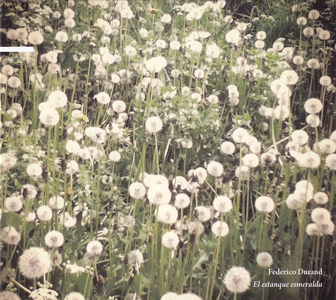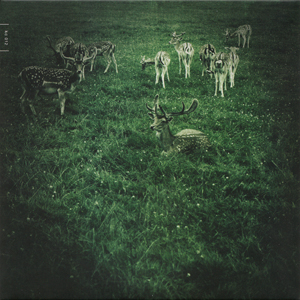Federico Durand, "El Estanque Esmeralda"; Melodía, "Saudades"
 Federico Durand has been quietly making a name for himself in the world of sparse, minimalist sounds that lay somewhere in a nebulous space between synthetic and organic. His use of field recordings and acoustic guitars place his work in a very naturalistic setting, while processed and occasionally distorted layers of sound are anything but. He works heavily within this dynamic on both this new solo record and his collaborative project with like-minded composer Tomoyoshi Date in two different, yet complementary releases.
Federico Durand has been quietly making a name for himself in the world of sparse, minimalist sounds that lay somewhere in a nebulous space between synthetic and organic. His use of field recordings and acoustic guitars place his work in a very naturalistic setting, while processed and occasionally distorted layers of sound are anything but. He works heavily within this dynamic on both this new solo record and his collaborative project with like-minded composer Tomoyoshi Date in two different, yet complementary releases.
One thing that El Estanque Esmeralda (The Emerald Pond) emphasizes is a tasteful use of distortion to give compositions a slightly dissonant, but also timeworn quality to them. The sense of nostalgia that pervades this album is no accident, with Durand's goal to re-create childhood memories with his grandparents.Light and gentle would be the most apt description of "La Linterna M√°gica," with hidden melodies and gentle river field recordings, but there is just an ever so slight bit of lo-fi grime to give it character."Nymphaea" also heavily features Durand's melodic tendencies, but deep below a world of analog hiss and what sounds like decaying magnetic tape.
The slight filtering appears again on "Un Claro del Bosque Iluminado por la Luz de Luna" but even more sparingly applied, instead first emphasizing the haunting melody that opens the piece and the heavy, glassy shimmering passages that close it."Iris, la Niña Invisble" utilizes both equally, with cautious piano notes and field recordings of croaking frogs with dense tones that slowly creep towards the harshness of feedback.The ending goes for what sounds like guitar and heavily filtered loops, resulting in a very different feel overall, both compared to the rest of the song and the album as a whole.
samples:
 Given the similar sounds Date works with in his other projects (Optiope, Illuha), it is unsurprising then that their Melodía collaboration does not drastically differ from Durand’s own solo work.Recorded while the duo was on a European tour and assisted by Stephan Mathieu, it was previously released as a limited LP.On pieces like "The Spirit of Rain Arrives Early to the Forest", Date’s influence seems to be mostly showcased with his relatively unprocessed acoustic guitar, with the ambient textures and field recordings possibly coming from either artist.Piano makes for the centerpiece of "An Old Photo of Our Family," floating nicely atop a bed of textural static and electronic melodies that result in two drastically different sounds paired together.
Given the similar sounds Date works with in his other projects (Optiope, Illuha), it is unsurprising then that their Melodía collaboration does not drastically differ from Durand’s own solo work.Recorded while the duo was on a European tour and assisted by Stephan Mathieu, it was previously released as a limited LP.On pieces like "The Spirit of Rain Arrives Early to the Forest", Date’s influence seems to be mostly showcased with his relatively unprocessed acoustic guitar, with the ambient textures and field recordings possibly coming from either artist.Piano makes for the centerpiece of "An Old Photo of Our Family," floating nicely atop a bed of textural static and electronic melodies that result in two drastically different sounds paired together.
The lengthy composition "The Rise of Early Morning" uses that duration to shift and develop greatly, first sounding like field recordings from a beach before soon being overtaken by sweeping tones and melodic passages.It then shifts to be a mass of dramatic electronics and tones, engulfing what organic elements that can be heard before ending in a mass of textural stutters and music box like tones."Riverside of the Poet's House" has similarly cinematic moments, first pairing clanging bells and extremely elongated tones.Found sounds are looped into some ersatz rhythm, and eventually the entire piece becomes quite dense, with these obscure bits mixed in with guitar and field recordings.
Both alone and with Date, Durand does an excellent job working with hushed sounds and dissonant atmospheres.El Estanque Esmeralda is the one that stays the most grounded of the two, which is why I tended to prefer the Saudades album a bit more.In both sound and mood it has a constantly shifting dynamic to it, and while it never becomes either too dissonant or too sparse, it is the wavering between these two extremes that leads me to favor it just a bit more.
samples:
 



